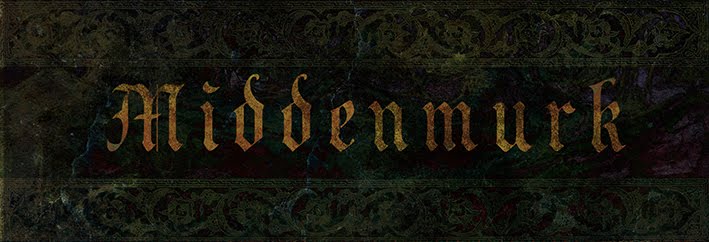
Disease is a big part of what makes the Dung Age conceptualisation of the Middle Ages such a rich vein of inspiration for me. The Forgotten Realms, where I played most of my teenage D&D, seemed to be an anodyne place, bereft of all the sickness, madness and brutality of the historical accounts of the mediaeval period I had read. I want to create a setting that is grimmer and darker and consequently much more fun.
Commonly encountered in the Vermin-pits of the Middenmurk, miasma is “bad air” that causes disease, a manifestation of pure corruption that issues forth from the Middenmurk to plague the unhappy world, bringing suffering and misery. Miasmata appear as hazy patches of air and as a sense of foreboding and the stench of decay, i.e. players should probably have some warning of their presence. They tend to drift along slowly on currents of foul air or lurk in particularly noisome areas.
Vitruvius on miasma, 1st Century AD;
"For when the morning breezes blow toward the town at sunrise, if they bring with them mist from marshes and, mingled with the mist, the poisonous breath of creatures of the marshes to be wafted into the bodies of the inhabitants, they will make the site unhealthy."
Fanatics (clerics) are able to cleanse miasma (as did Abaris the Hyperborean as mentioned in this Wikipedia article), doing so requires a turn undead check as against wights.
Having a nosegay of posies or marjoram will grant a character a +1 to their save.
Miasma Table
Roll 1d8 to determine what manner of contagion the miasma carries.
1. Ague: Fever, sweating, cramps, headache. Save vs. poison or lose 1d3 points of constitution per day and suffer -2 penalty to actions for 1d8 days, after which constitution returns at one point per day.
2. Dropsy: Swelling of the brain causing stupor and confusion. Save vs. poison or spell-casting and other tasks requiring concentration (such as finding secret doors) fail unless a wisdom check is successful. Duration: 2d6 days.
3. Flux: Diarrhoea, vomiting, cramps. Save vs. poison each day or lose a point of constitution. Three consecutive saves indicates recovery.
4. Grippe: Fever, mucus, lethargy. Save vs. poison or lose 1 point from intelligence, strength, constitution and charisma. Save again each day to recover.
5. Horrors: Hallucinations and shakes. Save vs. poison or lose 1d4 wisdom and dexterity. A wisdom check is necessary each time an action is attempted, failure indicates inability to perform task due to confusion. Duration: 1d6 days.
6. Palsy: Shakes and partial paralysis. Save vs. poison or lose 1d8 dexterity. Duration: 1d6 days.
7. Consumption: Coughing up blood, fatigue, fever. Save vs. poison or lose 1d3 points of strength and constitution per week unless subsequent save is made. Duration: 1d6 weeks.
8. Pox: Painful lesions, cramps, fever. Save vs. Poison or lose 1 hit point per day, and loss of 1d6 points of Charisma, one point of which is permanent. Duration: 2d8 days.
I'll figure a way of working them into some kind of encounter table at some stage.

Great concepts.
ReplyDeleteJust reading this makes me want to scrub with disenfectant. I don't think anyone will be writing travel brochures about Middenmurk. The unofficial motto should be, if you have to go to the Middenmurk get out as soon as you can. Great blog so far.
That table belongs in the 1e DMG; worthy of the man himself!
ReplyDeleteAnd those skeletons know how to PARTY!
word verification: snopur - sound a snow leopard makes.
Thanks guys.
ReplyDeleteI need to work in leprosy and the plague to round out the list of iconic olde timey diseases. But I thought they were special cases that needed special rules.
I can't remember ever reading about a leper colony in any D&D supplement ever. Why is that? What kind of Disneyfied world doesn't have the bell-ringing unclean to bring some atmosphere. I can imagine them hanging around outside dungeons begging alms from adventurers.
As far as D&D and leprosy. Well, a Cure Disease spell can do wonders for a case of Leprosy. So no Leper Colonies... Any Lawful Good Cleric should go out of his way to cure diseases, and heal the wounded.
ReplyDeleteNow if Leprosy was a magical curse, perhaps demonic in origin, then there might be problems. It wouldn't be nearly as easy to eradicate, or at least control.
A neat concept. Inspires me to use it for my own campaign. Personally, I use RuneQuest, which has the nice idea that disease can be either like a poison or carried by a spirit. Or both... Either way the affected character has to resist its strength (vs. Constitution or vs. the Power characteristic) or fall sick. Miasma fits right in with this, so thanks for the idea!
ReplyDeleteNever liked D&D's Cure Disease spell myself. Too neat and tidy a way to fix things up. I always thought you should have to go wash at a holy shrine or something to get rid of leprosy or rot grubs...
"As far as D&D and leprosy. Well, a Cure Disease spell can do wonders for a case of Leprosy. So no Leper Colonies... "
ReplyDeleteInteresting point. However, this runs contrary to the way I imagine the world. I guess the justification for the lack of squalor in high-fantasy D&D worlds is the presence of cheap and easily available magic, essentially analogous to technology, and producing conditions essentially similar to modernity.
In my vision, a sixth-level cleric (which is the minimum level necessary to access cure disease) is something akin to a saint. Having the miraculous power to cure disease and free lepers from their suffering should not be something to be taken for granted but something rare and wonderful. I agree with Dave that cure disease is too neat and tidy (and if there's one thing the Middenmurk isn't it's neat and tidy).